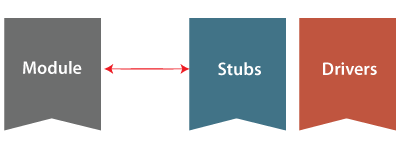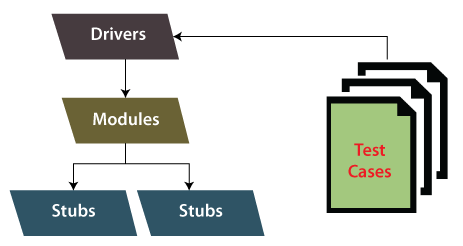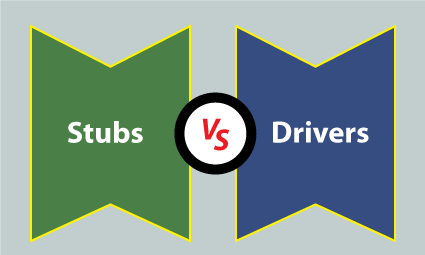In this section, we are going to discuss the difference between Stubs and Drivers; and see a brief introduction of them.
Stubs and drivers are two types of test harness that are a collection of software and test, which means they are designed together to test a unit of a program by accelerating the change of situations at the same time as regularly checking its performances and results.
In the Software Testing process, the Stubs and Drivers are those components that are used as a short-term alternative for a module.
There are several elements in the Software Testing Life Cycle, which play an essential role in the testing process to be more precise and trouble-free.
All the components connected to testing and try to enhance their quality, helps us to deliver an exact and predictable outcome, and facilities the fulfilment of the specified specifications.
Describe Stubs and Drivers in the Software Testing?
In Software Testing, the words stub and drivers described as a replica of the modules that operate as an alternative to the new or missing modules.
Stubs are mainly used in top-down integration testing; on the other hand, drivers are mainly used in bottom-up integration testing individually and designed the enhance the testing process.
To sustain the essential requirements of the inaccessible modules or components, we are precisely established the stubs and drives. And extremely beneficial in getting the anticipated outcomes.

Both Stubs and drivers are the essential part of the basic software development and software testing process. Thus, to help us understand the substance of stubs and drivers in software testing, we will see an exhaustive discussion.
What are Stubs?
- A stub is a replica of a module that collects the data and develops many possible data. However, it executes like an actual module and is mainly used to test modules.
- Generally, stubs are created by software developers in order to use them instead of modules if the particular modules are miss or not yet developed.
- By using these test stubs, the test engineers can simulate the performance of the lower-level modules, which are not yet joined with the software. Furthermore, it helps us to accelerate the activity of the missing modules.
Types of Stubs
In the top-down approach of incremental integration testing, the stubs are divided into four essential parts, which are as follows:
- Demonstrate the trace message.
- Exhibits the parameter values.
- Returns the consistent values, which are handled by the modules or the components.
- Returns the values of the specific parameters, which were utilized by testing components or modules.
What are Drivers?
- The Drivers establish the test environments and takes care of the communication, estimates results, and also sends the reports.
- These are just like stubs and used by software test engineers in order to accomplish the missing or incomplete modules/ components requirements.
- The drivers are mainly developed in the Bottom-up approach of incremental integration testing.
- Generally, drivers are bit complex as compared to the stubs.
- These can test the lower levels of the code when the upper-level modules or codes are not developed or missing.
- In other words, we can say that the Drivers perform as pseudo-codes, which are mainly used when the stub modules are completed; however, the initial modules/components are not prepared.
Examples of Stubs and Drivers
Let us see an example of stubs and drivers, which help us to enhance our knowledge of stubs and drivers.
Suppose we have one web application that contains four different modules, such as:
- Module-P
- Module-Q
- Module-R
- Module-S
And all the modules, as mentioned earlier, are responsible for some individual activities or functionality, as we can observe in the following table:
| Different Modules | Individual Activities |
|---|---|
| Module-P | Login page of the web application |
| Module-Q | Home-page of the web application |
| Module-R | Print Setup |
| Module-S | Log out page |
Note: Modules P, Q, R, and S encompasses the dependencies of each module over the other.
It is always a better approach to implement the testing or development of all the modules equivalently. The minute each gets developed, they can be combined and tested according to their similar dependencies with a module.
Once Module-P is developed, it will go through the testing process. But, to perform and validate the testing methods regarding Module-P, they need Module-Q, which is not yet developed entirely and still in the developing process.
And it is not possible to test Module-P on the lack of Module-Q. Thus, in such scenarios, we will take the help of Stubs and Drivers in the software testing process.
The Stubs and drivers will replicate all the basic functionality and features displayed by the real Module-Q. And subsequently, it is being combined with Module-P in order to execute the testing process effectively.
Now, we can validate the estimated functionality of the Login page, which was in Module-P, only if it is going to the Home Page, which is the activity of Module-Q as per the correct and valid inputs.
In the same way, stubs and drivers are used to accomplish the requirements of other modules, such as the Sign-out page, which comes under the Module-S and needs to be aimed to the Login page (Module-P) after effectively logging out from the particular application.
Likewise, we may also use Stubs or Drivers instead of Module-R and Module-S if they are not available.
As the result of the inaccessibility of Module-P, stubs and drivers will work as an alternate for it to perform the testing of Module-S.
But here, the question arises that both drivers and Stubs serve the same functionality?
Let's find the answer to the above question:
Yes, we can say that both stubs and drivers carry out similar features and objectives. Both of them act as an alternative for the missing or absent module. But, the change between them can be pictured throughout the integration testing process.
The key difference between Stubs and Drivers
The below facts explain the critical differences between stubs and drivers during the integration testing process.

- Stubs and Drivers design as a dummy for the missing or inaccessible modules or the components.
- Most commonly, stubs and drivers are used in the incremental integration testing, where stubs are used in top-bottom methodology while drivers are used in a bottom-up methodology.
- Usually, developers and unit test engineers are included in the creation of stubs and drivers.
- Even though it provides an ease to perform the separate components or the modules without worrying about the accessibility of other modules, and leads them into a time-consuming process, as it involves the development of replica for all the missing modules.
- Precisely, stubs and drivers are developed for each module holding different purposes.
Stubs VS Drivers
Here, we are discussing some significant comparisons between Stubs and Drivers in the below table:

|
S.NO. |
Stubs |
Drivers |
|
1. |
A section of code
that imitates the called function is known as Stubs. |
A section of code
that imitates the calling function is known as Drivers. |
|
2. |
It is used to test
the functionality of modules and test modules and also replicate the
performance of the lower-level module which are not yet merged, and the
activity of the missing module/components. |
When the main module
is prepared or ready, we will take the help of drivers. Generally, drivers
are a bit more complex as compared to the stubs. |
|
3. |
The stubs are
developed during the Top-down approach of incremental integration testing. |
The drivers are
developed during the bottom-up approach of incremental integration testing. |
|
4. |
Stubs replicate the
activity of not developed and missing modules or components. |
Drivers authorizes
test cases to another system and which refer the modules under testing. |
|
5. |
The stubs are
created by the team of test engineers. |
Mostly, the drivers
are created by the developer and the unit Test engineers. |
|
6. |
Stubs are developed
when high-level modules are tested, and lower-level modules are not formed. |
Drivers are acquired
when lower-level modules are tested, and higher-level modules are not yet
developed. |
|
7. |
These are parallel
to the modules of the software, which are under development process. |
On the other hand,
the drivers are used to reminding the component, which needs to be tested. |
|
8. |
The stubs signify
the low-level modules. |
The drivers signify
the high-level modules. |
|
9. |
Fundamentally, the
Stubs are also known as a called program and initially used in the Top-down
integration testing. |
The Drivers are also
known as the calling program and are mainly used in bottom-up integration
testing. |
|
10. |
These are reserved
for testing the feature and functionality of the modules. |
The drivers are used
if the core module of the software isn't established for testing. |
Conclusion
In this section, we have seen the significant difference between
Stubs and Drivers.
And we conclude that the software testing process cannot be
implemented with the unfinished and partial modules and components.
Hence, to ensure the correctness and efficiency of testing, it
is necessary to develop the stubs and drivers that satisfy the requirements of
unfinished modules.
And perform as simulated modules which are requested for testing
the features of main modules or components.
Lastly, we can say that the stubs and drivers are a vital part
of the software testing process.
They are computer programs that work as an alternative and
replicate the functionalities of the other modules, which help us simplify the
software testing activities.



0 Comments